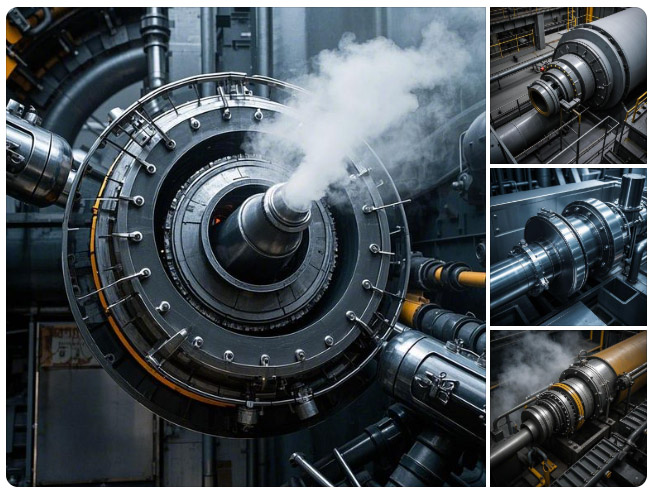The sealing devices of the rotary kiln mainly include fish scale seals, cylinder seals, graphite block seals, labyrinth seals and baffle seals.
Fish scale seals
Generally made of multiple layers of thin metal sheets (such as stainless steel), the shape is similar to fish scales, and they are arranged overlappingly. They can be divided into single-layer, double-layer and triple-layer sealing forms. These metal sheets have certain elasticity and flexibility, and can adapt to the movement and deformation of the rotary kiln cylinder. The overlap and elasticity between the fish scales are used to form a multi-layer sealing barrier to prevent the leakage of gas, dust and materials. When the kiln cylinder moves axially, radially jumps or swings, the fish scales can deform accordingly to maintain the sealing performance.
Cylinder seal
Mainly composed of a cylinder, a piston, a sealing baffle, etc. The cylinder is fixed to the kiln tail smoke chamber or other fixed parts through a bracket, and the piston is connected to the sealing baffle, which contacts or approaches the surface of the kiln cylinder to form a seal. The compressed gas in the cylinder generates thrust to press the sealing baffle tightly against the kiln cylinder to achieve sealing. By adjusting the air pressure in the cylinder, the pressure of the sealing baffle on the kiln barrel can be controlled to adapt to different working conditions and the movement of the kiln barrel. It is mainly used for the tail seal of the rotary kiln for producing powder and granular materials, and is generally used more in the cement industry.
Graphite block seal
The old graphite block seal adopts axial sealing, while the new graphite block seal adopts radial sealing. It is usually composed of several graphite blocks, which are installed in the sealing seat and contact or form a small gap with the surface of the kiln barrel. Graphite has good self-lubrication and high temperature resistance, and can maintain good sealing performance at high temperatures. A relatively sliding sealing surface is formed between the graphite block and the surface of the kiln barrel, and the leakage of gas and materials is prevented by the close arrangement of the graphite blocks and their own characteristics. It can be used for kiln tail sealing and kiln head sealing. The new graphite block seal will be the future development direction.
Labyrinth seal
It is composed of multiple circular baffles of different diameters combined into a labyrinth form, and a tortuous channel is formed between the baffles to increase the resistance to gas, dust and material leakage. By utilizing the tortuosity of the channel, the leaked gas, dust and materials change direction multiple times in the labyrinth channel, consuming energy and thus reducing the amount of leakage. The requirements for the equipment itself are high, and there are not many applications alone, but the combination of labyrinth seal and fish scale seal and the combination of seal and graphite block seal are still used in some enterprises.
Baffle seal
Generally, a heavy hammer or spring is used to support the baffle, which is opposite to the surface of the kiln barrel to form a sealing gap. The baffle is kept in a certain position by the force of the heavy hammer or spring to form a seal with the surface of the kiln barrel. When the kiln barrel moves, the baffle can follow the movement within a certain range to maintain the sealing effect. As an earlier form of sealing, it is similar to the cylinder seal, both of which are radial seals, but are now basically eliminated.
